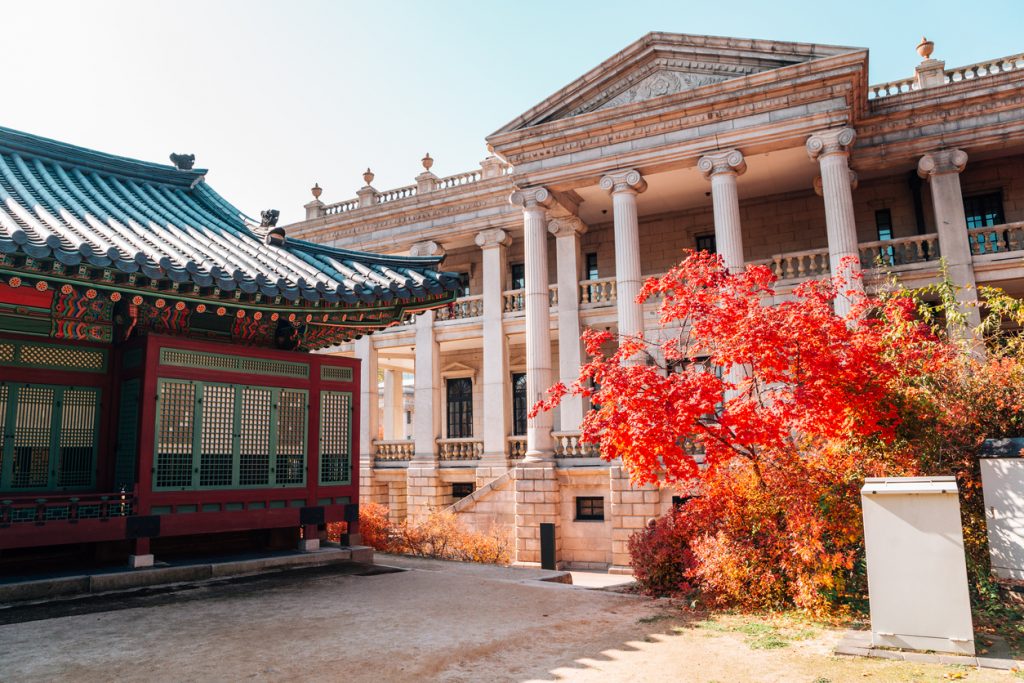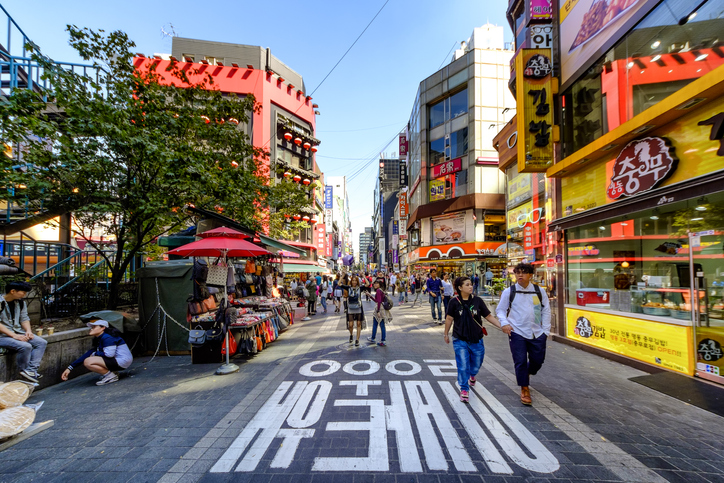Located on the southern half of the Korean Peninsula, South Korea is often overlooked as a tourist destination in favour of Japan or Southeast Asia. However, this fascinating country has lots to offer, especially for those planning a budget trip to South Korea. While there are plenty of luxury options, South Korea, and even its capital Seoul, are surprisingly affordable destinations. So, here’s how you can visit South Korea on a budget.
What Will This Article Cover?
This is a quick budget guide to South Korea where we’ll take a look at how to save money on your trip to South Korea. It will cover cost-effective transportation, food and accommodation hacks, free things to do in South Korea, and some budgeting tips.
When Should You Visit To Avoid Peak Season?
 The most popular time to visit South Korea is in summer (June–Sep). That’s when it’s crowded with tourists, and rates are at their highest. Instead, you can visit during autumn when the heat of the summer abates, and you can experience beautiful autumnal foliage. You can also visit during spring when temperatures are gentler than winter, and the trees are bursting with colourful flowers, especially cherry blossoms.
The most popular time to visit South Korea is in summer (June–Sep). That’s when it’s crowded with tourists, and rates are at their highest. Instead, you can visit during autumn when the heat of the summer abates, and you can experience beautiful autumnal foliage. You can also visit during spring when temperatures are gentler than winter, and the trees are bursting with colourful flowers, especially cherry blossoms.
Another way to both see South Korea on a budget and experience a whole other side of the country, would be to get out of the big cities and into the countryside to visit some of South Korea’s smaller towns, islands, mountains and national parks.
How Can You Make Transportation More Cost-Effective?
 One of the great things about budget travel in South Korea is that you’re never very far away from anywhere you might want to visit within the country; you can travel from one end to another in less than five hours. South Korea has an excellent public transportation system, making getting around a breeze. Trains, buses and planes connect most towns and cities, though the most cost-effective modes are trains and buses. Within cities, there are subway systems and public buses you can use, and the central districts of even the biggest cities like Seoul and Busan are walkable. Taxis are also surprisingly affordable, starting at 3,000 KRW (2.60 USD).
One of the great things about budget travel in South Korea is that you’re never very far away from anywhere you might want to visit within the country; you can travel from one end to another in less than five hours. South Korea has an excellent public transportation system, making getting around a breeze. Trains, buses and planes connect most towns and cities, though the most cost-effective modes are trains and buses. Within cities, there are subway systems and public buses you can use, and the central districts of even the biggest cities like Seoul and Busan are walkable. Taxis are also surprisingly affordable, starting at 3,000 KRW (2.60 USD).
An exciting South Korea travel hack: A foreign non-resident visiting the country can get a KR Pass that offers unlimited travel for a set period of time, or the T-Card that you can use on Seoul’s bus and metro system to save money on each ride.
How Can You Get The Best Out Of Your Accommodation?
 There are many excellent budget hotels and hostels around the country, especially in Seoul and Busan. You can find rooms in hotels within any price variation. The more adventurous among you can also select from great pod and capsule hotels. These provide basic amenities for less money than regular hotels, although they compromise on space.
There are many excellent budget hotels and hostels around the country, especially in Seoul and Busan. You can find rooms in hotels within any price variation. The more adventurous among you can also select from great pod and capsule hotels. These provide basic amenities for less money than regular hotels, although they compromise on space.
In South Korea, you can also get a place to sleep for as little as 10,000 KRW (8 USD) at jjimjilbangs (Korean saunas). At these co-ed sleeping areas, you’ll probably not find more than a mat and pillow. Don’t expect luxurious comfort when sleeping overnight in a Korean spa; however, it makes for a unique experience and fits perfectly within your South Korea budget trip.
How Can You Save Money On Food In South Korea?

You don’t have to spend a lot of money to eat well in South Korea. Korean comfort food (such as hearty soups, noodles, stews, and rice dishes) can be found at 24-hour kimbap shops for just 1,800 to 7,000 KRW (or 1.50 to 6 USD).
If you’re on a really tight budget, we can suggest a great South Korea food hack: Skip restaurants altogether and eat your fill at Gwangjang Market or opt for some of South Korea’s delicious and varied street food, especially on Sinchon Street in Seoul. Some things you could try are marinated meat barbecued at tableside grills (bulgogi), rice and cooked veggies served together in a big bowl (bibimbap), rice and vegetables rolled in seaweed (kimbap), and spicy rice cakes (tteokbokki).
Also Read: Mouth-watering Korean food you HAVE to try
What You Should Spend Your Money On, On A Budget Trip To South Korea

In South Korea, ATMs that accept foreign cards aren’t all that common. Keep a lookout for one that has a ‘Global’ sign or the logo of your credit card company. Do remember that they might close at 11 pm and that you might be charged a transaction fee. It’s best to exchange or withdraw your money at the airport. However, most major credit cards are widely accepted, except in the countryside.
South Korea has one of the fastest internet connections in the world, and most restaurants and cafes offer FREE Wifi. But, if you want to be connected all the time, you can buy a 4G SIM Card or rent a Pocket Wifi. SIM Cards have various prepaid plans available depending on how long you stay and can be bought at the airport. Pocket Wifi is chargeable by the day, but will give you unlimited access, and can connect up to 3 devices at once. Both usually work out much cheaper than an international plan on your regular SIM card, which is an important South Korea budget hack.
There are many amazing things you can buy in South Korea, such as skincare products and cosmetics, or traditional Korean tea (made from herbs and fruit infusions, rather than tea leaves!) and ginseng. They are also known for their green tea or nokcha. Shopping at underground subway stations, or on the street in university areas, and flea markets will get you better prices and bargains.
In general, tipping is not expected in South Korea, although Western-style tipping practices are on the rise at upscale restaurants and hotels, where it’s advisable to tip porters around KRW 100 to 500 (USD 0.10 to 0.50) per bag.
Things To Do In South Korea That Are (Almost) ALL FREE

If you’re visiting South Korea on a budget, you can find tons of things to do for free, like the following:
- The Seoul Global Cultural Centre has a variety of activities and workshops for visitors including K-POP dance lessons, traditional Korean cooking classes and much more.
- Seoul is also home to several excellent public parks, such as Namsan Park, where you can get amazing views of the city, or Seonyudo Park, an island in the middle of the Han River.
- You can also explore Bukchon Hanok Village, a traditional Korean village in the heart of Seoul, on your own, along with its many open-air museums, hip cafes, and cultural spaces.
- Most Buddhist temples, such as the Jogyesa Temple are also free to enter, and the best time of the year to visit is during Buddha’s birthday (April–May), when the entire temple is covered in colourful paper lanterns.
- There are lots of amazing museums in South Korea, like the National Museum of Korea and the Gyeongju National Museum. Most are either free on certain days or very cheap to visit, though access to special exhibitions within their grounds might come at an additional cost.
- You can go hiking in the lush green South Korean mountains for free, and those around Busan are some of the best.
So, What Kind Of A Traveller Would Enjoy South Korea On A Budget?
On average, you can spend less than 100,000 KRW (80 USD), per day if you stay at a hostel or at a jjimjilbang, and enjoy street food and adventure activities like hiking. However, you will end up spending around 200,000–300,000 KRW (160–240 USD) per day if you stay at a traditional guesthouse (or an Airbnb), frequent higher-end eateries, and spend more time at cultural sights like palaces and museums that have an entrance fee.
Remember, such a trip appeals best to budget travellers and those who want to avoid high-end hotels and expensive restaurants. Additionally, keep in mind that the DMZ tour costs 100,000 KRW (80 USD) if that is something you want to see.


